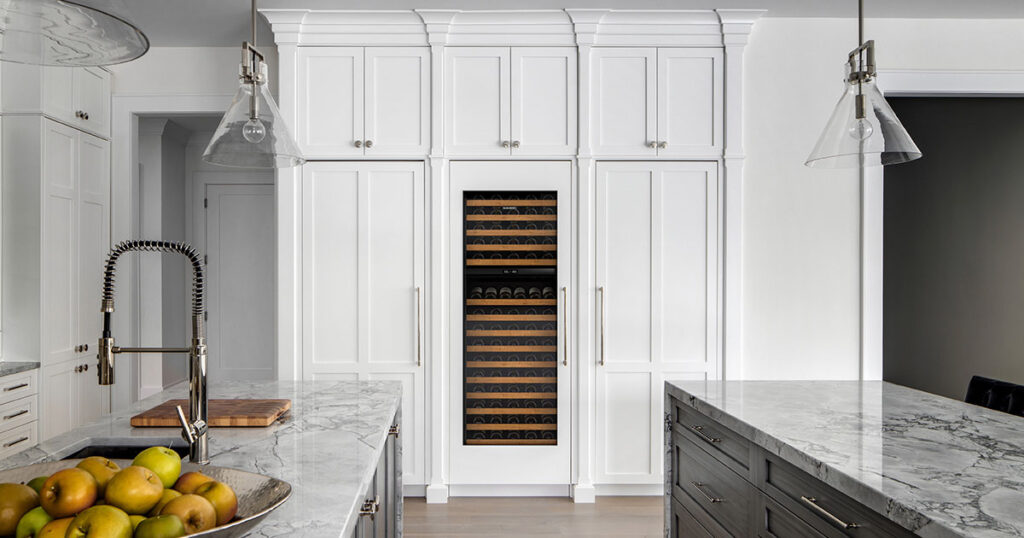Nothing conveys a sense of luxury in the kitchen quite like built-in refrigeration. And nothing disappoints clients more than when cabinetry errors and installation glitches thwart the sleek, high-end look they were after. To avoid those headaches and costly re-dos, keep these ABCs and make-or-break details in mind.
What is Built-in Refrigeration?
Built-in refrigeration is installed inside cabinetry. Generally, these units are less deep (but taller and wider) than their freestanding counterparts, which minimizes or eliminates any disruption to a continuous line of cabinets. Under the built-in umbrella, there are classic refrigerator/freezer units and single-purpose columns that can be configured in myriad ways.

Classic Built-in Refrigeration
One distinguishing feature of classic or legacy built-in refrigeration is the placement of the compressor at the top, typically combined with a louvered grille. These units come in various configurations, including side-by-side, French door, and over-and-under models. Both stainless-steel and panel-ready models are available.
With classic units, there are two installation options: standard and flush-inset. Note, however, that not all classic models can be installed flush. Selecting the right appliance is key if that’s the desired look.

Standard Installation
With a standard installation, the refrigerator and freezer doors will extend beyond—or sit proud of—the surrounding cabinetry, typically by a couple of inches. When paneled, some stainless steel will likely be exposed on the sides, so the final result may not be as sleek as the homeowner envisioned.
Flush-Inset Installation
Flush-inset refrigeration, on the other hand, aligns perfectly with the adjacent cabinets. Custom frameless or inset cabinetry works best to achieve this look. With a flush installation, there will be a gap of a minimum of ½ inch around the perimeter of each panel to allow the door(s) to clear the cabinet frame.
Some manufacturers require a kit for flush installation. If using a flush-mount kit with a paneled unit, be aware that stainless-steel trim will show around the perimeter, which can be disappointing to customers who expected a completely seamless look.

Column Refrigeration
Integrated, modular columns offer the ultimate in luxury and customization. Single-purpose refrigerators, freezers and wine-storage towers units can be mixed and matched to create the ideal width and configuration to suit your design and your clients’ cold-storage needs. A joining kit(s) will likely be required.
Columns can only be installed flush. When paneled, they seamlessly meld into the run of cabinets. This high-end refrigeration choice calls for custom cabinetry; it’s nearly impossible to achieve the intended look with stock cabinets.
Cabinetry and Panel Considerations
When it comes to cabinetry and installation, our mantra is always the same: read the manufacturer’s specifications and design guide. Even still, it’s easy to overlook a critical detail. Here are a few that are worth underscoring:
- Framed cabinets require additional filler material behind the face frame for proper installation. These blind returns allow the mounting fasteners to attach securely. The filler material will be visible when the doors are open, so it must be finished to match the cabinetry.
- For both standard and flush-inset installations of frameless cabinetry, finished reveals are needed. The interior sides, top, and bottom of the cabinets should be finished 3 ½ to 6 inches to match the cabinetry, as those areas could be exposed when the door is open.
- Flush applications necessitate cabinetry that is deeper than the 24-inch standard, so custom solutions work best.
- Flush-inset installations require a cleat to be installed to both sides and the top of the rough opening. Some parts of the cleats will be visible, so they must be finished to match the cabinetry.
- Custom panels should be finished on all sides; a portion may be visible when the door is open.
Achieving the sleek, high-end look that homeowners want comes down to choosing the right appliances and then getting the surrounding cabinetry and panels just right, too. Mistakes can be costly and time-consuming. These tips could potentially save you thousands of dollars and tons of aggravation. When your client is ready to choose luxury refrigeration and other kitchen appliances, send them to Friedman’s, where our experts are ready to help.
